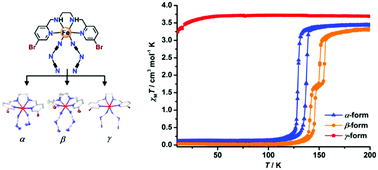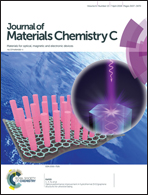Multiple spin phases in a switchable Fe(ii) complex: polymorphism and symmetry breaking effects†
Abstract
Polymorphism in spin-crossover (SCO) compounds allows accessing additional forms of switchable materials with diverse transition properties. We have prepared three polymorphs of a new complex [FeLBr(dca)2], where LBr is N,N′-bis[(5-bromo-2-pyridyl)methyl]ethane-1,2-diamine and dca is dicyanamide. They display different SCO properties: the α-form displays a hysteretic one-step switch centered at 134 K, the β-form undergoes hysteretic two-step spin transition with a plateau (T1/2 = 153 and 144 K) and the γ-form remains high spin (HS) over the whole temperature region. The kinetic origin of the hysteresis loop was demonstrated in temperature rate dependent magnetic measurements. Spin transition in the α-form is accompanied by symmetry breaking from a single Fe(II) site in the HS state to two distinct Fe(II) sites in the low spin (LS) state. In the β-form, the single crystal XRD has revealed a re-entrant symmetry change associated with the stepwise transition, with an ordered HS–LS alternating arrangement in the temperature plateau range. The corresponding Mössbauer study demonstrates a complicated evolution of spin transitions in the β-form through three different spin phases within different temperature regions.



 Please wait while we load your content...
Please wait while we load your content...